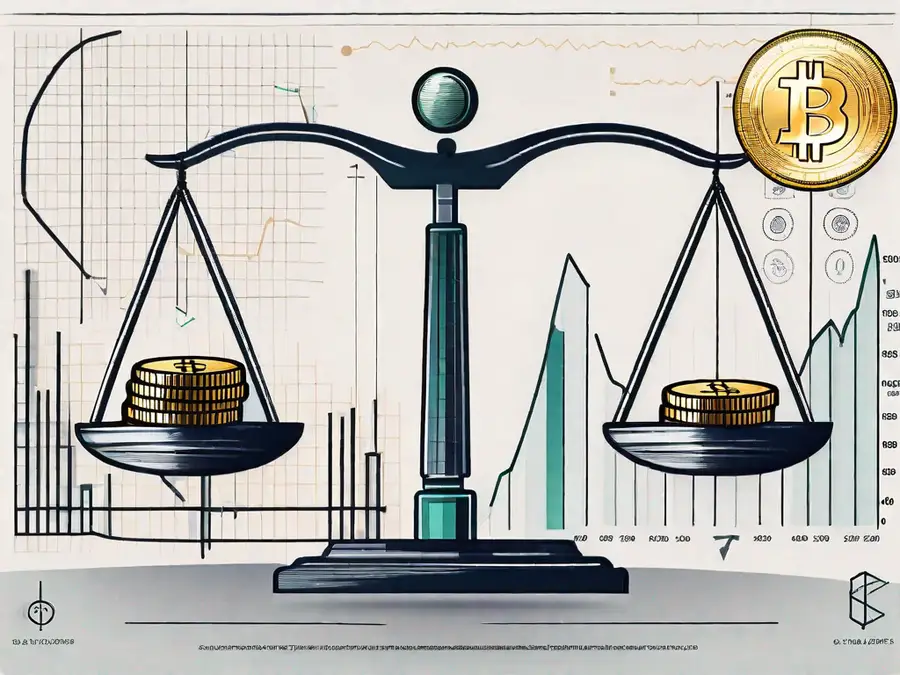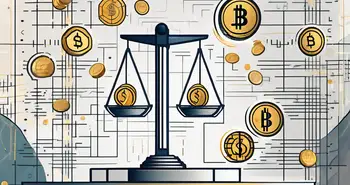What Are Stablecoins, and Are They a Good Investment?

Stablecoins have gained significant attention in the world of cryptocurrencies. As an expert in the field, I'm often asked about their basics, role in the market, pros and cons of investing, and considerations before making investment decisions. In this article, I will provide a comprehensive guide to stablecoins and whether they are a good investment option for you.
Understanding the Basics of Stablecoins
Stablecoins have gained significant attention in the world of cryptocurrencies due to their ability to minimize price volatility and offer stability to investors. While cryptocurrencies like Bitcoin and Ethereum are known for their wild price swings, stablecoins are designed to maintain a stable value by being pegged to a specific asset, such as a fiat currency or a commodity.
Definition of Stablecoins
Stablecoins are a type of cryptocurrency that aims to provide stability in the volatile crypto market. Unlike traditional cryptocurrencies, stablecoins are backed by a reserve of assets, which helps maintain their value. This makes stablecoins an attractive option for investors who want to avoid the rollercoaster ride of price fluctuations.
How Stablecoins Work
The main idea behind stablecoins is to ensure that their value remains relatively constant, usually at a ratio of 1:1 with the pegged asset. This stability is achieved through various mechanisms, including collateralization, algorithms, or decentralized governance.
Collateralized stablecoins are backed by reserves of assets, such as fiat currency or commodities, held in custodial bank accounts. These reserves act as a guarantee for the stablecoin's value, providing investors with confidence in its stability.
Algorithmic stablecoins, on the other hand, rely on smart contracts and algorithms to maintain price stability without the need for collateralization. These algorithms automatically adjust the supply of stablecoins based on market demand, ensuring that the price remains stable.
Decentralized governance is another mechanism used by stablecoins to maintain stability. In this model, the stablecoin's value is governed by a decentralized community of token holders who make decisions collectively. This democratic approach helps ensure that the stablecoin remains stable and free from external manipulation.
Different Types of Stablecoins
There are several types of stablecoins available in the market, each with its own unique features and mechanisms for maintaining stability.
- Fiat-collateralized stablecoins: These stablecoins are backed by reserves of fiat currency held in custodial bank accounts. The reserves are audited regularly to ensure transparency and maintain stability. Examples of fiat-collateralized stablecoins include Tether (USDT) and USD Coin (USDC).
- Commodities-collateralized stablecoins: These stablecoins are pegged to the value of a specific commodity, such as gold or oil. The stablecoin's value is backed by physical assets, providing stability even in times of market volatility. Examples of commodities-collateralized stablecoins include Digix Gold (DGX) and Petro (PTR).
- Algorithmic stablecoins: These stablecoins rely on smart contracts and algorithms to maintain price stability. The algorithms automatically adjust the supply of stablecoins based on market demand, ensuring that the price remains stable. Examples of algorithmic stablecoins include DAI and Ampleforth (AMPL).
- Hybrid stablecoins: These stablecoins combine elements of different types, leveraging both collateralization and algorithmic mechanisms. This hybrid approach aims to provide enhanced stability and flexibility. Examples of hybrid stablecoins include Reserve Rights (RSR) and Terra (LUNA).
Each type of stablecoin has its own advantages and disadvantages, and investors should carefully consider their preferences and risk tolerance before investing in stablecoins.
The Role of Stablecoins in the Cryptocurrency Market
Stablecoins play a crucial role in the cryptocurrency market by providing a bridge between traditional finance and digital assets. They offer stability, liquidity, and a safe haven for investors seeking less volatility. Stablecoins also enable easy and efficient transfer of value across different cryptocurrencies and exchanges, acting as a reliable medium of exchange.
But what exactly are stablecoins and how do they work? Stablecoins are a type of cryptocurrency that are designed to maintain a stable value, usually pegged to a specific asset like the US dollar or a basket of currencies. This stability is achieved through various mechanisms, such as collateralization, algorithmic control, or a combination of both.
One popular type of stablecoin is the fiat-collateralized stablecoin. These stablecoins are backed by reserves of traditional fiat currencies, such as the US dollar or the Euro, held in bank accounts. The value of the stablecoin is directly linked to the value of the underlying fiat currency, ensuring stability.
Another type of stablecoin is the algorithmic stablecoin. These stablecoins use smart contracts and algorithms to maintain their value. For example, if the price of the stablecoin drops below its target value, new coins are minted to increase supply and stabilize the price. Conversely, if the price rises above the target value, coins are burned to reduce supply and bring the price back down.
The Purpose of Stablecoins
Stablecoins serve several important purposes in the cryptocurrency market. Firstly, they provide a stable and reliable medium of exchange. While cryptocurrencies like Bitcoin or Ethereum are known for their price volatility, stablecoins offer a familiar currency-like experience with reduced risk. This makes stablecoins an attractive option for both investors and businesses looking for stability in their transactions.
Stablecoins also play a crucial role in facilitating the adoption of cryptocurrencies in everyday transactions. By providing a stable value, stablecoins make it easier for individuals and businesses to use digital assets for everyday purchases, without having to worry about price fluctuations.
Furthermore, stablecoins enable easy and efficient transfer of value across different cryptocurrencies and exchanges. This is particularly important in a decentralized and fragmented market like the cryptocurrency market, where there are numerous cryptocurrencies and exchanges with different liquidity and trading pairs. Stablecoins act as a common medium of exchange, allowing users to easily move value between different cryptocurrencies and exchanges.
Stablecoins vs Other Cryptocurrencies
Compared to other cryptocurrencies, stablecoins provide a more predictable and stable store of value. While cryptocurrencies like Bitcoin or Ethereum are known for their price volatility, stablecoins offer a familiar currency-like experience with reduced risk. This stability makes stablecoins an attractive option for investors looking for a safe haven in times of market uncertainty.
Moreover, stablecoins offer liquidity and ease of use that other cryptocurrencies may lack. With stablecoins, users can easily convert their digital assets into a stable and widely accepted form of value, without the need for complex trading strategies or reliance on specific trading pairs. This accessibility and liquidity make stablecoins a popular choice for both experienced traders and newcomers to the cryptocurrency market.
In conclusion, stablecoins play a vital role in the cryptocurrency market by providing stability, liquidity, and a safe haven for investors. They enable easy and efficient transfer of value across different cryptocurrencies and exchanges, acting as a reliable medium of exchange. With their predictable and stable value, stablecoins offer a familiar currency-like experience with reduced risk, making them an attractive option for both investors and businesses.
The Pros and Cons of Investing in Stablecoins
Stablecoins have gained significant attention in the world of cryptocurrency investments. These digital assets are designed to maintain a stable value, often pegged to a fiat currency like the US dollar. While stablecoins offer certain benefits, they also come with their fair share of risks. In this article, we will explore the pros and cons of investing in stablecoins.
Benefits of Stablecoin Investments
Investing in stablecoins comes with several advantages:
- 1. Stability: Stablecoins offer a safe haven with relatively stable prices, making them an excellent choice for risk-averse investors. In a volatile cryptocurrency market, stablecoins provide a sense of security and predictability.
- 2. Liquidity: Stablecoins are widely accepted and easily convertible, providing high liquidity for transactions and investments. This liquidity makes it convenient for investors to enter or exit positions quickly without facing significant price slippage.
- 3. Accessibility: Stablecoins are available on various cryptocurrency exchanges, allowing easy access for investors worldwide. Unlike some traditional financial markets, stablecoins offer global accessibility, enabling investors from different countries to participate without barriers.
These benefits make stablecoins an attractive investment option for those looking for stability, liquidity, and accessibility in the cryptocurrency space.
Risks Associated with Stablecoin Investments
Although stablecoin investments have their advantages, it's vital to consider the risks involved:
- 1. Counterparty Risk: Some stablecoins may rely on third-party custodians or collateral, introducing counterparty risk that could impact stability. Investors need to assess the credibility and reliability of the custodian or collateral provider to ensure the stability of the stablecoin.
- 2. Regulatory Risk: As the regulatory environment for cryptocurrencies evolves, stablecoins may face regulatory challenges, affecting their acceptance and value. Changes in regulations or the introduction of new laws could impact the stability and usage of stablecoins.
- 3. Trustworthiness: Investors need to carefully assess the credibility and transparency of the stablecoin provider to mitigate any potential risks. The lack of transparency or auditability in the stablecoin's operations could raise concerns about its trustworthiness.
Considering these risks is crucial for investors to make informed decisions when investing in stablecoins. Conducting thorough research and due diligence can help mitigate potential pitfalls.
In conclusion, stablecoins offer stability, liquidity, and accessibility in the cryptocurrency market. However, investors should be aware of the counterparty risk, regulatory risk, and the need for trustworthiness when considering stablecoin investments. By understanding both the benefits and risks, investors can make well-informed decisions and navigate the evolving landscape of stablecoin investments.
Factors to Consider Before Investing in Stablecoins
Investing in stablecoins can be a smart move for those looking for stability in the volatile world of cryptocurrencies. However, before diving into this investment option, there are several factors that you should carefully consider.
Understanding Market Volatility
While stablecoins offer stability, it's essential to consider the broader cryptocurrency market's volatility. The cryptocurrency market is known for its wild price swings, and stablecoins are not immune to these fluctuations. It's crucial to understand the market dynamics and potential risks associated with investing in stablecoins. By doing so, you can make more informed investment decisions and avoid any unexpected surprises.
Market volatility can be influenced by various factors, such as economic events, regulatory changes, and investor sentiment. Keeping a close eye on these factors and staying updated with the latest market trends can help you navigate the cryptocurrency market more effectively.
Regulatory Considerations
Regulations surrounding stablecoins may differ across jurisdictions. It's crucial to stay updated with the legal and regulatory frameworks governing stablecoin operations in your country or region. Different jurisdictions may have varying approaches to stablecoin regulation, ranging from strict oversight to more lenient policies.
Understanding the regulatory landscape is essential for ensuring compliance and mitigating any potential legal risks. By familiarizing yourself with the rules and regulations, you can make informed decisions and avoid running afoul of the law.
Additionally, regulatory changes can significantly impact stablecoin investments. New regulations or government interventions can introduce uncertainties and affect the stability of stablecoins. Therefore, it's crucial to monitor regulatory developments and adapt your investment strategy accordingly.
The Importance of Due Diligence
Prior to investing in stablecoins, conducting thorough due diligence is of utmost importance. Due diligence involves researching and evaluating the stablecoin's issuer, collateralization methods, and audit reports.
When evaluating the stablecoin's issuer, consider factors such as their reputation, track record, and financial stability. Look for stablecoins issued by reputable organizations with a proven history in the cryptocurrency industry.
Collateralization methods play a crucial role in maintaining the stability of stablecoins. Understanding how the stablecoin is backed and ensuring that the collateralization is transparent and reliable is essential. Look for stablecoins that provide regular audits and reports to verify their collateralization practices.
Audit reports are another essential aspect of due diligence. These reports provide an independent assessment of the stablecoin's financial health and the accuracy of its claims. Look for stablecoins that have undergone thorough audits by reputable third-party firms.
By conducting thorough due diligence, you can identify trustworthy stablecoins and minimize investment risks. It's important to remember that investing in stablecoins, like any investment, carries inherent risks. Therefore, being diligent and informed is crucial for making sound investment decisions.
Future of Stablecoins in the Financial Market
Predicted Trends for Stablecoins
The future of stablecoins looks promising. They are likely to see increased adoption as a reliable medium of exchange and store of value. Furthermore, technological advancements, such as blockchain and decentralized finance (DeFi), may lead to the development of more innovative and efficient stablecoin solutions.
Impact of Stablecoins on Global Economy
The widespread adoption of stablecoins has the potential to revolutionize the global economy. They can facilitate cross-border transactions, improve financial inclusion, and reduce dependence on traditional banking systems. Stablecoins offer a fast and cost-effective alternative, enabling seamless global transactions with enhanced speed and transparency.
In conclusion, stablecoins provide an appealing investment option for risk-averse individuals and businesses seeking stability in the volatile cryptocurrency market. Their ability to maintain a stable value, liquidity, and easy accessibility makes them a valuable addition to any investment portfolio. However, investors should carefully consider the associated risks and conduct thorough due diligence before making any investment decisions. As an expert in the field, my personal advice would be to allocate a portion of your investment portfolio to stablecoins, taking advantage of their stability while diversifying your overall cryptocurrency holdings.
As you consider the potential of stock trading and the broader cryptocurrency landscape, why not expand your investment horizon with Morpher? At Morpher.com, you can leverage the power of blockchain technology to trade across a multitude of asset classes, including cryptocurrencies, without the burden of fees or liquidity constraints. With the ability to engage in fractional investing, short selling, and up to 10x leverage, Morpher offers a unique and flexible trading experience that aligns perfectly with the innovative spirit of crypto mining. Take control of your investments with the safety of the Morpher Wallet and explore new market opportunities today. Sign Up and Get Your Free Sign Up Bonus to embark on a transformative trading journey with Morpher.

Disclaimer: All investments involve risk, and the past performance of a security, industry, sector, market, financial product, trading strategy, or individual’s trading does not guarantee future results or returns. Investors are fully responsible for any investment decisions they make. Such decisions should be based solely on an evaluation of their financial circumstances, investment objectives, risk tolerance, and liquidity needs. This post does not constitute investment advice.

Painless trading for everyone
Hundreds of markets all in one place - Apple, Bitcoin, Gold, Watches, NFTs, Sneakers and so much more.

Painless trading for everyone
Hundreds of markets all in one place - Apple, Bitcoin, Gold, Watches, NFTs, Sneakers and so much more.









